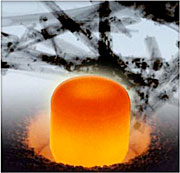- Number 344 |
- August 22, 2011
Predicting plutonium’s solubility

New research demonstrated the
effect of goethite on reducing
less-soluble plutonium to a
more-soluble form.
A hard-to-detect but stable form of iron helps convert subsurface plutonium from barely to very soluble, according to scientists at DOE’s Pacific Northwest National Laboratory and Rai Enviro-Chem, LLC. Plutonium resides underground at weapons sites around the world. In one form, abbreviated Pu(IV), it essentially stays put. But when soluble iron and a stable iron oxide are present the plutonium becomes more soluble, easily mixing with water. Soluble plutonium is a concern because it could mix with groundwater and flow into rivers and streams.
Underneath weapons sites, plutonium and other radioactive remnants are present and become difficult to isolate and remove. Complete removal of these materials can be costly and complex. Discovering how to keep radioactive material in the soil and out of the groundwater, whether it is in the United States, Russia, or elsewhere, could protect people and the environment without incurring extreme expenses.
This work was supported by DOE's Office of Biological and Environmental Research as part of the Subsurface Biogeochemical Research Science Focus Area at PNNL. Portions of the work were performed at EMSL, a national scientific user facility sponsored by BER and located at PNNL.[Kristin Manke, 509.372.6011,
kristin.manke@pnnl.gov]
